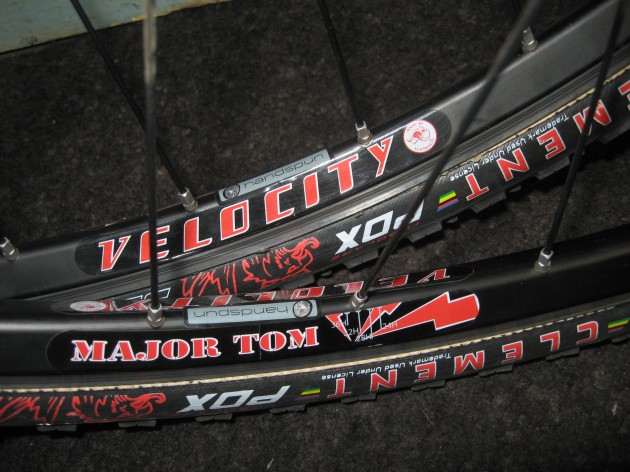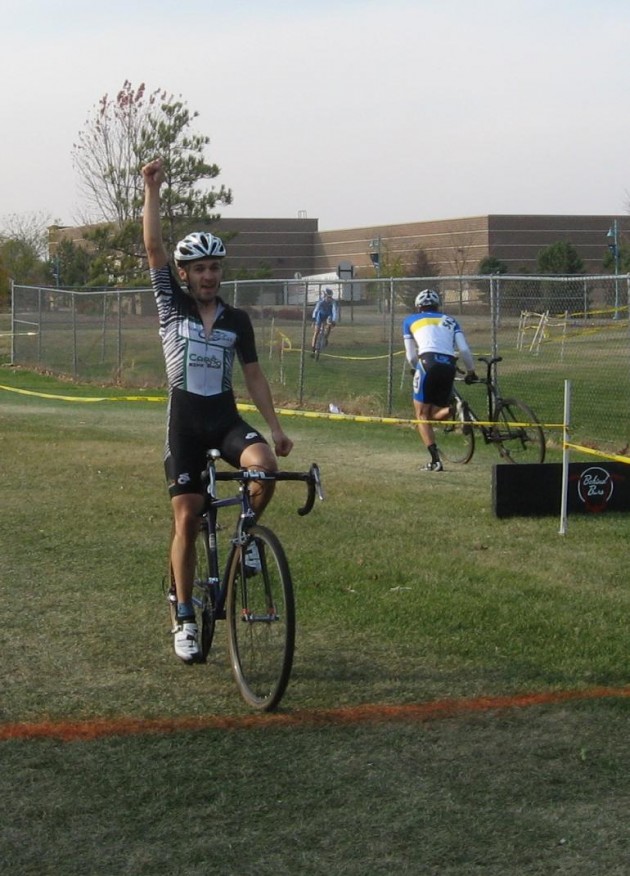This fall, one of Pavé’s loyal supporters Handspun sent us a set of their wheels to test. They had done the same earlier in the year, and we published our thoughts about their house-built HED Belgium wheelset here. We also took a trip to their headquarters to see what it is about their operations that lets them provide such high quality, high value wheels.
Recently, Handspun wanted to get a set of their cyclocross tubular wheelsets underneath us, and sent us a set of Velocity Major Toms tied around Shimano Ultegra hubs. Each is built with 32 spokes, handtensioned by Handspun’s expert wheelbuilding staff. I glued up a set of all-purpose tubular tires, adjusted my cantilever brakes to work with a wider rim, and made them my go-to set for local cyclocross races.
HANDSPUN’S WHEELS
The wheels that Handspun sent are a traditionally built, wide-bed tubular rim – Velocity’s Major Tom. In our previous review we talked a bit about the recent surge of wide rims and the benefits they provide for clincher wheelsets. The benefits they provide for cyclocross are a bit different, but salient: a wider rim bed means more surface area for glue adhesion and, similar to with clinchers, results in a tire profile that may be grippier. I have nothing to compare it to – no experience with cross tires on narrower tubulars, so the latter point doesn’t ring strongly with me. However, the first point – greater tire adhesion – is a welcome one, as many races from the amatuer to the professional level see even riders on gear maintained by experienced mechanics roll tubular wheels.
In recent years, Velocity’s Major Tom was one of the first wide tubular rims to parlay HED’s foray into wide clinchers into tubular rims. They’re not alone – major manufacturers developed wide tubulars for a variety of reasons (including tire profile and aerodynamics), and minor ones have developed wide, aluminum cyclocross tubulars.
The particular wheelset that Handspun sent us were no pigs, but not particularly lightweight. I’ve raced cyclocross on lighter clincher setups, but while I favor light wheels to help air out my steel frame and for ease of barrier crossings on my diminutive, 125-lb frame, it’s not necessary. I focused on experiencing the purported benefits of tubulars.
THE PROBLEM
Now, I’m a decent cyclocross racer. Just decent. Competitive as a Cat 3 and likely to spend future years as a middling Cat 2. I usually ride high-quality clinchers. Since I’m light, I ride them at precariously low pressures. My body weight won’t deform ‘cross tires at 30+ psi enough to get them to grip hard when I corner tightly, so I plunge below 30psi, try to ride gracefully and have been fortunate to avoid pinch flats in all but one race in four years.
However, there’s always a point at which clinchers get squirrely. Take a corner fast and aggressive and they’ll stop responding predictably. They’ll deform unsurely, fold over, and there’s a moment when they’re about to collapse, they want your front wheel to twist, behave errativelly. Racing fast on clinchers is a delicate attempt to get right up to that line without crossing it. Not that it’s impossible – French National Champion Francis Mourey started his 2010-2011 season in the United States, racing on clinchers.
But us amateurs? We’re not Francis Mourey. We need all the help we can get. In road racing, needing all the help we can get often means aero wheels – and thus carbon tubulars have become ubiquitous in amateur racing. This trend has, to a certain extent, carried over to cyclocross – plenty of people ride carbon tubulars for their strength, for their tubular aspect, and for some mysterious other gains (sand and mud clearance) that never seemed to me to be sufficient to merrit the price tag or the risk of breaking your spring-and-summer carbon in an evitable autumn tangle.
For cyclocross, the solution is clear: aluminum tubulars. Simple technology, used for decades and decades. Rather than being obselete in an era of carbon wheels and electric shifting, alumninum tubulars have retained their value by providing the greatest performance benefit for your dollar. Your wheel system doesn’t need to be fancy. Quite the opposite, they should be workman’s wheels. The rims wil take hits. You’ll crash them, or somebody will crash into you. You’ll ride them roughly, bend spokes. If you treat them right, you’ll throw them into the back of your friend’s pickup truck going to and from races. You’ll race them, you’ll brake hard on them and hope for a braking surface that doesn’t complicate the already finnicky nature of cantilevers. You’ll spend your money on expensive tires, and you’ll leave the expensive rims for the springtime.
THE RESULTS
I’ve put many races and several sessions of singletrack into Handspun’s tubular wheelset and the difference they make is astounding. I didn’t expect the improvement in ride and cornering to be this significant – in fact, I’m always wary of a psychosomatic upgrade experience, where new gear feels “laterally stiff but vertically compliant” just because it’s new. But the advantage that tubulars have is clear from the first warm-up lap I took.
The further I leaned over in turns, the more they showed their improvement over clinchers. They responded with constant predictability, a reliable and consistent grip that resulted in increased cornering confidence. No waggling of the front wheel – just precise steering and handling grounded in the reliable way that a tubular tire reacts. I can’t imagine myself going back to clinchers.
I’ve struggled with cyclocross this season. I’ve watched gaps open as the superior technical skill of other riders manifests itself in front of me. I’ve kept up with the lead riders only to be distanced on the last lap. I’ve watched people take good lines through corners only to take bad ones myself, struggling for grip. In one race, I closed the gap to a lone leader with a tired chaser stuck to my wheel, and my front wheel washed out on a slick, dead-grass corner on the last lap – a chance to duke it out for the win turned into a third place for me.
Since riding the tubulars, though, the handling improvement and confidence has improved my technical ability, and I even won two races. Now, is that strictly because of the wheels? Probably not. But my riding has definitely improved. Yours will too.
Because of these wheels I’m a thorough convert to tubulars for cyclocross, and because of their sensitibility I’m a proponent of handbuilt, aluminum-rimmed wheels. The strength of a wheel lies in its build – which is why I’d choose Handspun-built wheels again. And for those seeking an additional level of fancy, they’ve probably got whatever you’d need to upgrade a set – fancier hubs, bladed spokes, whatever. They’re sitting on top of the biggest cycling warehouse on the continent, and their expert builders probably get more experience in a month than most bike shops get in a year.
Cyclocosm recently posted some interesting food for thought about the woes of cyclocross clinchers and tubeless setups (Part One, Part Two). The answer is clear. Leave your carbons for next spring. Choose a basic Handspun set. Spend on tires. They’ll last and last. And in this era of increasingly expensive and disposable bike parts, lasting is of value.




Have your local shop build your wheels. Handspun are poorly (uneven) tensioned-poorly built wheels.
Hey there Rick. I've ridden two pairs of Handspun-built wheels pretty thoroughly. Both came to me very evenly-tensioned, and have stayed that way.
Rick-
I don't know what your experience has been on Handspun wheels, but I'd like to put it out there that if you (or anyone else for that matter) have any issues with Handspun wheels we want to know about it so that we can take care of you. We pride ourselves on building top quality wheels, and every wheel that we build is hand-trued, stress releived, tension checked on DT Swiss tensiometers (checked for calibration every 30 days), and perfectly dished- from our most expensive to our most affordable, every wheel gets the same treatment.
If you've got specific comments or questions please feel free to contact me directly @ dcory@qbp.com – I would love the opportunity to hear your issues and change your mind about Handspun.
Take care,
David